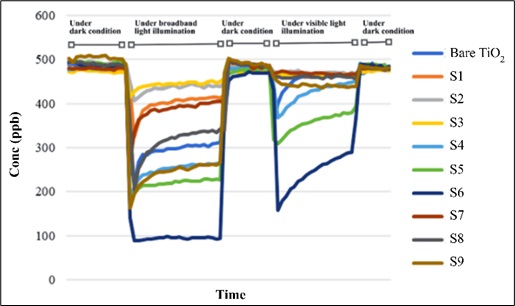Effect on NOx Abatement Performance of Metallic and Bimetallic (Copper and Platinum) Photodeposition onto TiO2 Anatase
Abstract
To enhance the TiO2 anatase's ability to degrade nitrogen oxides (NOx), this study seeks to optimize the photocatalytic activity, selectivity, and DeNOx index of anatase TiO2 nanoparticles through surface modification using metallic and bimetallic (Cu dan Pt) photodeposition. The samples' photocatalytic performance is assessed by NOx abatement measurement, while their characteristics are analyzed using UV-Vis diffuse reflectance and an X-ray diffractometer. According to the measurement, S6 (0.05% Pt/TiO2) has a photonic efficiency of 0.17 for the degradation of NOx, which is 2.15 times higher than bare TiO2. The DeNOx index, which combines selectivity and photonic efficiency, suggests that S9 (0.05% Pt + 0.1% Cu/TiO2) is the most effective sample in the visible light region, with a value of 0.01. Under broadband illumination, S6 has a DeNOx index of 0.13, which is the highest among all samples, while S9 has a moderate-level DeNOx index of 0.019. All samples have a higher DeNOx index than the bare anatase TiO2 nanoparticles. Bimetallic samples exhibit the best performance under visible light, whereas Pt-modified TiO2 anatase performs best in the broadband light range.
Downloads

Copyright (c) 2024 Chairul Ichsan, Widya Febriani

This work is licensed under a Creative Commons Attribution-NonCommercial-NoDerivatives 4.0 International License.
Authors who publish with this journal agree to the following terms:
- Copyright on any article is retained by the author(s).
- The author grants the journal, the right of first publication with the work simultaneously licensed under a Creative Commons Attribution License that allows others to share the work with an acknowledgment of the work’s authorship and initial publication in this journal.
- Authors are able to enter into separate, additional contractual arrangements for the non-exclusive distribution of the journal’s published version of the work (e.g., post it to an institutional repository or publish it in a book), with an acknowledgment of its initial publication in this journal.
- Authors are permitted and encouraged to post their work online (e.g., in institutional repositories or on their website) prior to and during the submission process, as it can lead to productive exchanges, as well as earlier and greater citation of published work.
- The article and any associated published material is distributed under the Creative Commons Attribution-NonCommercial-NoDerivatives 4.0 International License.





_copy1.png)










